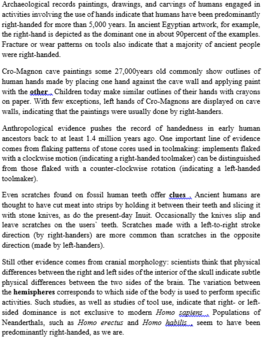Read the following passage and mark the letter A, B, C, or D on your answer sheet to indicate the correct answer to each of the questions from 28 to 34.
Because the low latitudes of the Earth, the areas near the equator, receive more heat than the latitudes near the poles, and because the nature of heat is to expand and move, heat is transported from the tropics to the middle and high latitudes. Some of this heat is moved by winds and some by ocean currents, and some gets stored in the atmosphere in the form of latent heat. The term “latent heat” refers to the energy that has to be used to convert liquid water to water vapor. We know that if we warm a pan of water on a stove, it will evaporate, or turn into vapor, faster than if it is allowed to sit at room temperature. We also know that if we hang wet clothes outside in the summertime, they will dry faster than in winter, when the temperature is lower. The energy used in both cases to change liquid water to water vapor is supplied by heat - supplied by the stove in the first case and by the Sun in the latter case. This energy is not lost. It is stored as vapor in the atmosphere as latent heat. Eventually, the water stored as vapor in the atmosphere will condense to liquid again, and the energy will be released to the atmosphere.
In the atmosphere, a large portion of the Sun’s incoming energy is used to evaporate water, primarily in the tropical oceans. Scientists have tried to quantify this proportion of the Sun’s energy. By analyzing temperature, water vapor, and wind data around the globe, they have estimated the quantity to be about 90 watts per square meter, or nearly 30 percent of the Sun’s energy. Once this latent heat is stored within the atmosphere, it can be transported, primarily to higher latitudes, by prevailing, large - scale winds. Or it can be transported vertically to higher levels in the atmosphere, where it forms clouds and subsequent storms, which then release the energy back to the atmosphere.
The passage mentions that the tropics differ from the Earth’s polar regions in which of the following ways?
A. The height of cloud formation in the atmosphere.
B. The amount of heat they receive from the Sun.
C. The strength of their large scale winds.
D. The strength of their oceanic currents.






Chọn đáp án B
Bài đọc đề cập đến các vùng nhiệt đới khác với các vùng cực của trái đất như thế nào?
A. Độ cao của việc hình thành đám mây trong khí quyển
B. Lượng nhiệt mà chúng nhận được từ mặt trời
C. Sức gió trên phạm vi rộng
D. Sức mạnh của dòng hải lưu
Dẫn chứng: Because the low latitudes of the Earth, the areas near the equator, receive more heat than the latitudes near the poles, and because the nature of heat is to expand and move, heat is transported from the tropics to the middle and high latitudes. (Do vĩ độ thấp của trái đất nên các vùng gần xích đạo nhận được nhiều nhiệt hơn vĩ độ gần cực, và bởi vì bản chất của nhiệt là lan truyền và di chuyển nên nhiệt được luân chuyển từ các vùng nhiệt đới đến các vĩ độ trung bình và cao.)